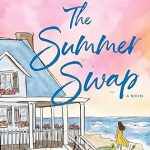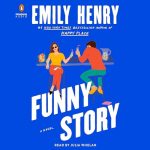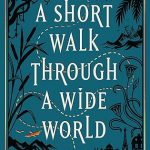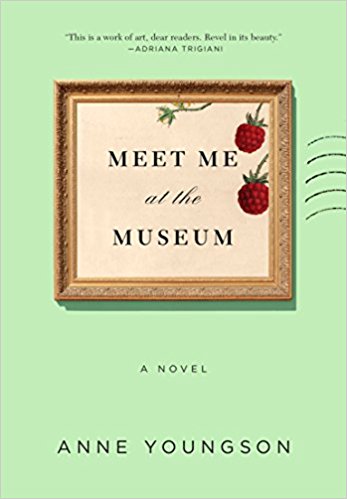 Meet Me at the Museum by Anne Youngson
Meet Me at the Museum by Anne Youngson Format: eARC
Source: supplied by publisher via Edelweiss
Formats available: hardcover, paperback, large print, ebook, audiobook
Genres: literary fiction, women's fiction
Pages: 272
Published by Flatiron Books on August 7, 2018
Purchasing Info: Author's Website, Publisher's Website, Amazon, Barnes & Noble, Kobo, Bookshop.org
Goodreads
“Warm-hearted, clear-minded, and unexpectedly spellbinding. A novel to savor.” —Annie Barrows, co-author of The Guernsey Literary and Potato Peel Pie Society
In Denmark, Professor Anders Larsen, an urbane man of facts, has lost his wife and his hopes for the future. On an isolated English farm, Tina Hopgood is trapped in a life she doesn’t remember choosing. Both believe their love stories are over.
Brought together by a shared fascination with the Tollund Man, subject of Seamus Heaney’s famous poem, they begin writing letters to one another. And from their vastly different worlds, they find they have more in common than they could have imagined. As they open up to one another about their lives, an unexpected friendship blooms. But then Tina’s letters stop coming, and Anders is thrown into despair. How far are they willing to go to write a new story for themselves?
My Review:
Meet Me at the Museum is a quietly marvelous little gem of a book. That it is also the author’s debut novel just makes it that much more special.
This is an epistolary novel, which is a fancy way of saying that the entire story is written as a series of letters. In this particular case, the letters are between two semi-accidental correspondents, both in their early 60s, who find themselves asking each other some of the big questions.
Questions like, “Does my life have meaning?” and, “Have I been my best self?”, as well as, “Where do I go from here?” and the big one, “Is this all there is?”
They are both at crossroads in their lives, and neither of them seems to have anyone with whom they can discuss what is really important to them – or to even to reveal what is really important to them.
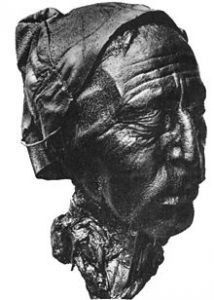
Tina has just lost her best friend. The friend who has been with her since childhood. And the one with whom she made a vow to go to Denmark and see the Tollund Man. When they were girls, the expert on this archaeological artifact, this Iron Age man who was dug up (or perhaps decanted) from a peat bog in Denmark, wrote a book about the Tollund Man and dedicated to his daughter and to all the children in their class in East Anglia. (This book, with its dedication, really does exist although the rest of this story is fiction.)
Tina writes to that author, all these years later, because she is putting her own thoughts down on paper, thoughts she wishes she could ask, not the old professor, but the Tollund Man himself. If he could talk.
The man who answers her from Denmark is the current curator of the museum, Anders. And at first his answers are rather dry and factual. He’s still grieving the recent death of his wife, and dry and factual seems to be all that he has in him.
But, the writing of the letters is cathartic for Tina, even if at first Anders isn’t very responsive in an emotional sense. So she keeps writing. And he keeps responding, and as he responds they step cautiously towards friendship. A friendship that is lacking in both their lives.
Anders is alone. He has his work and his children. Those children are grown now, and are beginning to have children of their own. He loves them, and they love him, but he cannot confide in them as equals. Writing to Tina becomes a solace for him. Her friendship allows him to hope again.
Tina is married, and also has children who are now having children of their own. But she is also alone – a fact which grows on both her and the reader through this correspondence. She should be talking with her husband but the fact is that they don’t really talk. They have a life together, but it is his life as a family farmer in East Anglia, a life that Tina did not want but was persuaded into when she became pregnant at 20. The person she really is only exists on the margins of her life. Her husband is one of those people for whom the only way is his the right way which is his way in everything, and he ruthlessly suppresses any of Tina’s impulses that don’t mesh with his way of life on his farm.
In her correspondence with Anders she can share her innermost thoughts. For that matter, she can share that she HAS innermost thoughts. They share the hopes, doubts and fears that neither of them is able to express to anyone in their daily lives.
So when Tina’s life finally breaks, Anders is more than willing to catch her. The question is whether she will be able to let him.
Escape Rating A+: This is absolutely completely marvelous. You wouldn’t think that reading a bunch of letters written between two strangers would be so utterly compelling, and yet it is. The reader feels like a secret witness to their correspondence, turning to each new letter as eagerly as its intended recipient.
That the two characters are both 60 or thereabouts is an interesting choice. This is a debut novel, and the writer herself is also (more or less) at that age. As am I. With modern medical science, 60 is no longer truly old, but one is certainly aware that one is no longer young. We may have 30 or even more years of mostly healthy and active living to do, but at the same time some choices are irrevocably behind us and some patterns are now too established for us to want to change even when change is possible.
Much of what Anders and Tina explore in their letters is at that crossroads. They are both aware of the roads not taken, and are searching for the meaning both in the choices they made and the ones they passed by – and whether or not it is too late to pick up some threads they left behind along the way.
This book is also the story of an emotional affair. When the story reaches its end, they have still not met in person. There are no possibilities for actual infidelity on Tina’s part, but she has come to invest a great deal of emotional capital in this relationship – which she has kept secret from her husband. That there is something wrong in her marriage becomes increasingly clear as the story progresses, and her relationship with Anders becomes both a wellspring of solace and a source of guilt as her life reaches its crisis. She has to take time out to recognize that the depth of her correspondence with Anders is a symptom of what is wrong and not its cause – but it isn’t easy.
Then again, nothing worth having or doing ever is truly easy. But Tina and Anders are marvelous and sympathetic characters. As they get to know each other, we get to know them – and we want them to find the answers to all those important questions – and to find their own best happiness.
Both the story and the way it is presented remind me very much of 84 Charing Cross Road, of which I have extremely fond memories. It may also remind readers of The Guernsey Literary and Potato Peel Pie Society, which is unfortunately lost in the depths of my towering TBR pile.
But I like the comparison to 84 Charing Cross Road a bit better, although where Charing Cross has a definitive and slightly tragic ending, Meet Me at the Museum is both less definitive and more hopeful. I like leaving the book with the possibility that Tina and Anders may have brighter days ahead. And astonishingly, Meet Me at the Museum may be the first work of literary fiction that I have not merely liked, but actually, sincerely loved. I hope that you will, too.











